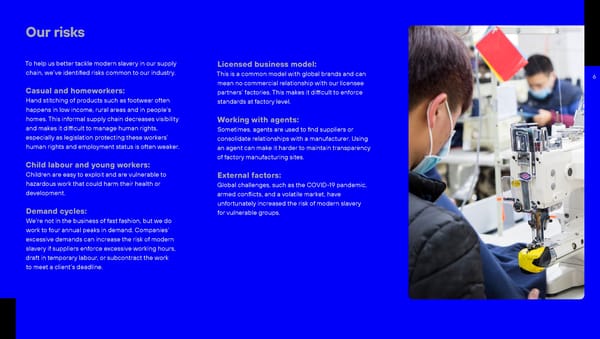Our risks To help us better tackle modern slavery in our supply Licensed business model: chain, we’ve identi昀椀ed risks common to our industry. This is a common model with global brands and can 146 mean no commercial relationship with our licensee Casual and homeworkers: partners’ factories. This makes it di昀케cult to enforce Hand stitching of products such as footwear often standards at factory level. happens in low income, rural areas and in people’s homes. This informal supply chain decreases visibility Working with agents: and makes it di昀케cult to manage human rights, Sometimes, agents are used to 昀椀nd suppliers or especially as legislation protecting these workers’ consolidate relationships with a manufacturer. Using human rights and employment status is often weaker. an agent can make it harder to maintain transparency of factory manufacturing sites. Child labour and young workers: Children are easy to exploit and are vulnerable to External factors: hazardous work that could harm their health or Global challenges, such as the COVID-19 pandemic, development. armed con昀氀icts, and a volatile market, have unfortunately increased the risk of modern slavery Demand cycles: for vulnerable groups. We’re not in the business of fast fashion, but we do work to four annual peaks in demand. Companies’ excessive demands can increase the risk of modern slavery if suppliers enforce excessive working hours, draft in temporary labour, or subcontract the work to meet a client’s deadline.
 2022 | Modern Slavery Report Page 7 Page 9
2022 | Modern Slavery Report Page 7 Page 9